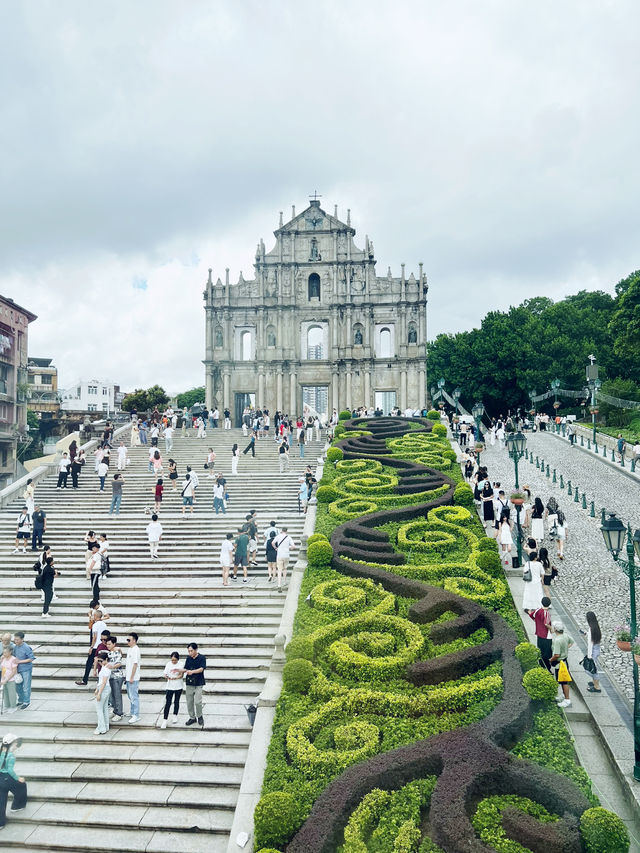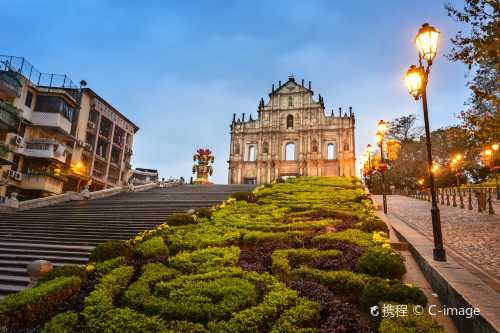App
Customer support
Find bookings
🏝️ Macau Day Trip Guide (Cotai → Main Island) Start: Macau International Airport Endpoint: Macau Peninsula (around Galaxy, Starwood Hotel) Features: Zero-cost transportation, luxury attractions in series, walking and strolling super smooth! ⸻ 🚶♀️ First stop: From Macau Airport • Location Tip: After exiting the airport gate, go straight to the right. • About a 3–5 minute walk, you’ll see a whole row of “free shuttles from major hotels” stops. • Free buses are available to almost all major hotels (no accommodation traveler status required). 📍Recommended to take: The Venetian shuttle bus 👉 Direct access to the center of Cotai City, the most convenient transportation, about 10 minutes after departure. ⸻ 🎰 Second stop: The Venetian Macao • Featured highlights: • The Grand Canal Shoppes, the largest indoor shopping center in Macau, is themed around the Venice Canal. • Gondola experience with artificial waterway and crew singing. • Major boutique brands, designer stores, restaurants, desserts. • You can also try your luck at the Venetian Casino (21 years old or older). 🕒 Recommended length of stay: 1.5–2 hours 🍴Recommended snacks: Italian ice cream, Macau Portuguese tart specialty shop. ⸻ 🌉 Stop 3: The Parisian Macao Accessible directly from the Venetian via the skywalk, very convenient! • Featured highlights: • The Eiffel Tower with a 1/2 scale exterior is the most representative photo spot in Macau. • In the evening there will be a romantic tower light show. • Large fountain and French streetscape decoration can be seen indoors. • There are also many mid-to-high-end brands and dessert shops in the shopping area. 🕒 Recommended length of stay: 1–1.5 hours 📸 Check-in suggestion: Plaza in front of the Eiffel Tower, fountain area. ⸻ 🇬🇧 Stop 4: The Londoner Macao You can reach it by walking about 5 minutes further from the Parisian. • Featured highlights: • The exterior is in the classic British architectural style (like a scaled-down version of Tower Bridge and Big Ben). • The interior is lavishly decorated with many “English street” elements. • The museum sells many Macau-exclusive merchandise and British-branded souvenirs. • There are a number of English restaurants and afternoon tea shops (such as Gordon Ramsay’s). 🕒 Recommended length of stay: 1–1.5 hours 🍴Recommended: English fish and chips, afternoon tea. ⸻ 💎 Stop 5: Galaxy Macau It is about 10–15 minutes walk from Londoners (also available by free shuttle). • Featured highlights: • Luxury shopping center and large entertainment area. • The most well-known is the Galaxy Diamond Show (every 30 minutes). 💎 Huge crystal diamonds rotate with music and spray water light effects, very spectacular! • The pavilion has numerous high-end brands and dessert cafes. 🕒 Recommended stay time: 1 hour ⏰ Diamond Show Time: Starts every half hour on the hour (about 5 minutes). ⸻ 🚌 Stop 6: Head to Macau Main Island (Peninsula) You can take a free shuttle bus from the Galaxy Hotel to areas such as the StarWorld or the Grand Lisboa. • About 15 minutes drive. • After getting off the bus, you enter the busy area of the Macau Peninsula, where you can continue to explore freely. ⸻ 🏮 Stop 7: Macau Peninsula Free Tour The following routes can be arranged: 1. Starwood Hotel → Grand Lisboa → Ruins of St. Paul’s → Rose Hall → Guanye Street 2. Or experience local street food and small casino culture directly on the island. 🍴Recommended snacks: Yishun stewed milk, pork chop bun, Portuguese egg tart, almond cake. 🕒 Recommended stay time: According to physical arrangement, can play until evening or after dinner back to the hotel. ⸻ ✈️ Back to Suggestion • To return to the airport, take any major hotel shuttle bus back to the airport (mostly ring shuttle). • It is recommended to reserve 1 hour drive + 2 hour airport check-in time. ⸻ ✅ Summary Suggestions Itinerary Paragraph Attractions Suggested Dwell Time Remarks 1 Airport → Venetian 10 minutes drive Free shuttle 2 Venetian 1.5–2 hours Indoor canal, casino 3 Parisians 1–1.5 hours Eiffel Tower Check-in, fountain 4 Londoners 1–1.5 hours English street view, restaurants 5 Galaxy 1 Hour Diamond Show 6 to Peninsula 15 minutes drive Free bus 7 Peninsula walks Flexible arrangements Tai Samba, Guan Ye Street, etc
JASON_PAI
Exploring Macau with a Dash of Hong Kong Magic 🏰✨ Get ready for a city break that mixes glitzy casinos, old-school charm, and jaw-dropping sunsets! If you’re nearby, Hong Kong is a must-add for your itinerary—seriously, don’t miss the lit-up Disneyland Castle at night for peak photo vibes. Top Spots to Visit in Macau: 1. Ruins of St Paul’s (Largo da Companhia de Jesus, 8 AM–6 PM): Iconic façade and outdoor cultural vibes, perfect for sunrise pics. 2. Senado Square (Central Macau, 24/7): Cobblestones + pastel architecture = Instagram gold. Go early for quieter scenes! 3. Macau Tower (Estrada do Istmo, 10 AM–9 PM): Modern architecture with 360° views—sunset here is next level. 4. A-Ma Temple (Barra Pagoda, 7 AM–6 PM): Experience authentic culture under ancient prayer trees. 5. Cotai Strip (Av. da Nave Desportiva, open daily): Cloudy or sunny, this place dazzles with lights and western-style casino buildings. 6. Taipa Village: Outdoor natural scenery meets trendy cafés. Come hungry! Personal Tips: + If you’re hopping to Hong Kong, budget a night for Disneyland—the castle glows like a movie scene after dark. + Pack for changeable weather; Macau goes from sunny to rainy fast. + Walking is best for old Macau’s nooks. For Cotai and casinos, use the free hotel shuttles. Food to Try: Scan for street egg tarts near Senado Square or dive into African Chicken at Restaurante Litoral in Taipa Village. Transport Hack: TurboJET ferries zip you from Hong Kong to Macau in under an hour—grab tickets on trip.com for easy planning. Don’t forget: Macau runs on the Pataca, but most places accept HKD. Bring a light jacket for breezy nights! #MacauAdventures #HongKongMustVisit #SunsetVibes #TripDotCom #EggTartHunters
_TI***mz
Popular Trip Moments
Macau Modern Magic✨ | Macau Wandering: Encountering Layers of History and the Vibrancy of Life in a Day’s Walk | Christmas Season in Macau: A Magical City Sparkling Like Snow | The Most Beautiful View of Sea and Sky | The Gilded Daydream | A small piece of Europe in Asia with a stunning Eiffel Tower view, Macau. | A Feast of Speed and Passion! The Complete Guide to the 2025 Macau Grand Prix | Guangdong-Hong Kong-Macao Private Car Service | Fast Direct Access · Exclusive Ride with No Hidden Charges | Come to Macau!! I finally found the luxury bag store that makes my heart race | When in Macau, don't miss this colorful fairytale photo spot | The Parisian Hotel, a highly recommended hotel in Macau, a paradise for vacations🩷 | A complete photo guide! 9 must-check-in Portuguese-style colorful houses in Macau! | Hidden Gem for a Relaxing Getaway | In-depth exploration of the Macau Museum 🎻 | Lion sculpture check-in choice 🐾 | Get the ultimate street photography tool in Macau here! Instantly become the heroine of a romantic drama | Macau Travel Guide | 【Macau】Ruins of St. Paul's Cathedral | Macau Aesthetic Spot: Nagomi Lobby Lounge🪔 | St. Regis Macao | Macau also wants South Beauty. | Macau Bear Theme Cafe is a new hotspot for check-in 🐻 | Chimelong Safari Park One-Day Blitz Route | Macau's Ruins of St. Paul's: A Blend of History and Modernity | A Sunday Key: When the People's House Greets Its People | Directly copy this itinerary, I'm so afraid you'll miss this colorful Macau route | Macau's super healing colorful neighborhoods! 100% photo-worthy! | Don't miss the Romantic Chapel in Macau! | Macau Revisit - Rio Hotel | Where Urban Threads Meet Hypercar DNA
Recommended Attractions at Popular Destinations
Popular Attractions in Kuala Lumpur | Popular Attractions in Iguazu National Park(Argentina) | Popular Attractions in Walt Disney World Resort | Popular Attractions in Dubai | Popular Attractions in Paris | Popular Attractions in Los Angeles | Popular Attractions in Barcelona | Popular Attractions in Bangkok | Popular Attractions in Rome | Popular Attractions in London | Popular Attractions in Singapore | Popular Attractions in Osaka | Popular Attractions in New York | Popular Attractions in Zanzibar Island | Popular Attractions in Bali | Popular Attractions in Melbourne | Popular Attractions in Beijing | Popular Attractions in Shanghai | Popular Attractions in Sydney | Popular Attractions in Las Vegas | Popular Attractions in Tokyo | Popular Attractions in Chefchaouene | Popular Attractions in Kyoto | Popular Attractions in Phuket | Popular Attractions in West Lake | Popular Attractions in Chengdu | Popular Attractions in Florence | Popular Attractions in Madrid | Popular Attractions in Istanbul | Popular Attractions in Jungfrau Region
Popular Restaurants in Macau
Five Foot Road(MGM COTAI) | Yee Shun Milk Company | Luk Kee Noodle | WONG CHI KEI | Chan Seng Kei | Macau Ming Kee Beef food | IMPERIAL COURT(MGM MACAU) | Lai Heen | Pearl Dragon | Mok Yi Kei | DUMBO RESTAURANTE | The Eight | Loja Sopa De Fita Cheong Kei | ROBUCHON AU DÔME | Loja de Doces Hang Heong Un | Talay Thai Restaurant | Mesa by José Avillez | Emperor Court | SW Steakhouse | CHÚN(MGM COTAI) | Churchill's Table | Margaret's Cafe e Nata | Restaurante Fernando | Nam Ping | Sing Lei Cha Chaan Teng | Jade Dragon | Palace Garden | Chiado | Wing Lei | Wong Kun Sio Kung
Popular Ranked Lists
Top 50 Must-Visit Restaurants in Bangkok | Top 50 Best Things to Do in Vancouver | Popular Premium Hotels in Ji'an County | Popular Premium Hotels in Bole | Top 50 Must-Visit Restaurants in Barcelona | Top 10 Best Things to Do in Naha | Popular Luxury Hotels in Warsaw | Popular Premium Hotels in Zixi | Top 10 Best Things to Do in Kathmandu | Top 50 Must-Visit Restaurants in Yangzhou | Top 50 Must-Visit Restaurants in Taipei | Top 50 Best Things to Do in Venice | Top 20 Best Things to Do in Stockholm | Popular Luxury Hotels in Malolo Island | Top 50 Best Things to Do in Milan | Popular Best Things to Do in Canberra | Top 50 Must-Visit Restaurants in Munich | Top 50 Must-Visit Restaurants in Songyang | Top 20 Best Things to Do in Jakarta | Top 20 Luxury Hotels in Madrid | Top 20 Luxury Hotels in Los Angeles | Top 50 Must-Visit Restaurants in Frankfurt | Popular Premium Hotels in Emboodhu Finolhu | Popular Premium Hotels in Jiexiu | Top 50 Must-Visit Restaurants in New York | Top 10 Best Things to Do in Siem Reap | Top 50 Must-Visit Restaurants in Kyoto | Top 50 Must-Visit Restaurants in Auckland | Top 50 Must-Visit Restaurants in Chengdu | Top 10 Best Things to Do in Kanazawa
About
Payment methods
Our partners
Copyright © 2025 Trip.com Travel Singapore Pte. Ltd. All rights reserved
Site Operator: Trip.com Travel Singapore Pte. Ltd.
Site Operator: Trip.com Travel Singapore Pte. Ltd.



















